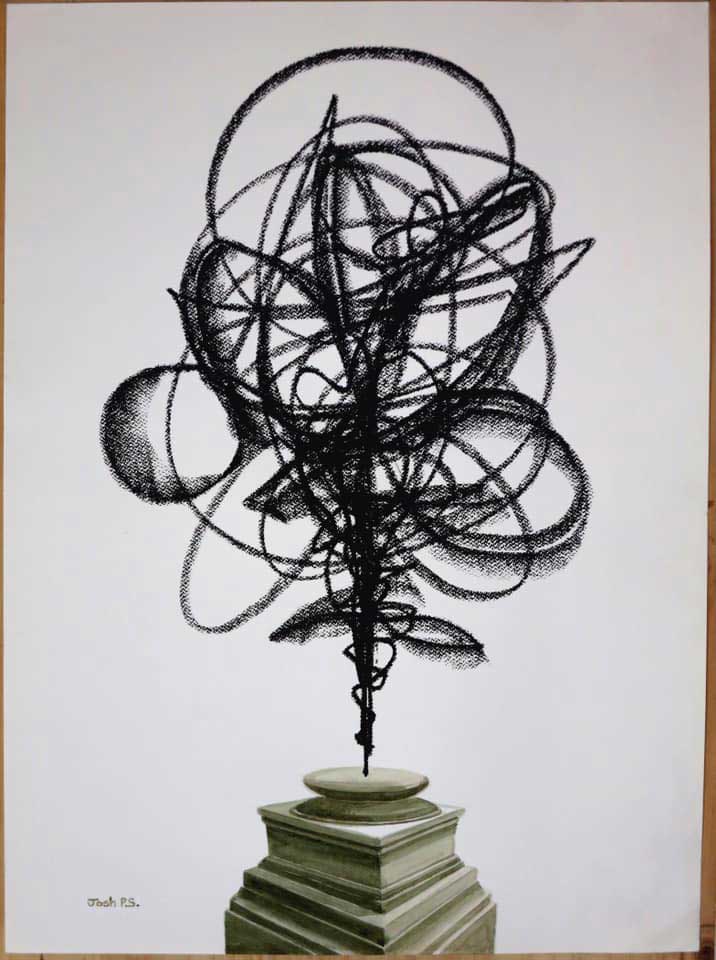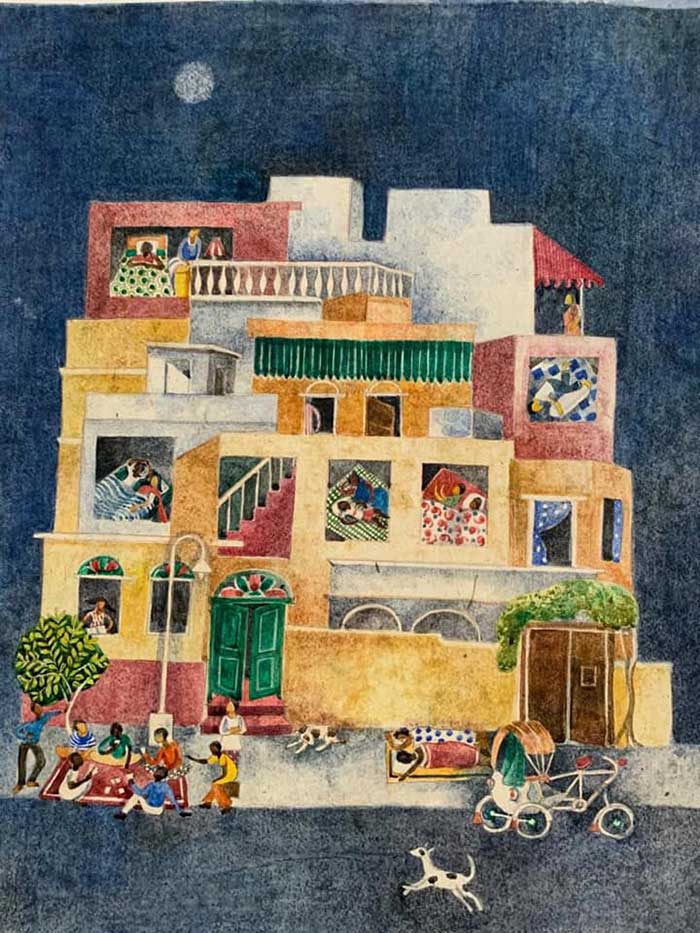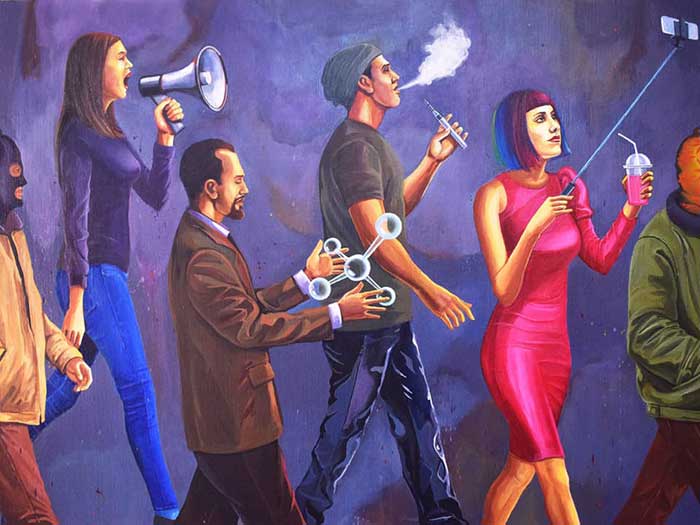
While the art of protest is curating its own shows in the streets across the country, an art show titled ‘Rustic Footmarks’, recently held in Kochi has raised a question-mark over uncritically endorsing the generic term ‘Indianness’ and the autonomy of art
The first act is the speech of silence enacted on the upfront. An art show has recently held in Kochi, Kerala under the umbrella rubric, ‘Rustic Footmarks”. The group show has been a representation of 29 contemporary artists across the country and their works are intended to be in line with the common theme the ‘rustic’. The show was inaugurated in a traditional Hindu way of lighting the golden ceremonial lamp. The artists each in turn obediently lighted the wicks arranged around the holder top of the lamp. The atmosphere was almost all like a religious ceremony. No problem, nothing exceptional, I assured myself, it is only a ritual, a formality or a routine; nothing to worry as the ceremonial lamp is historically understood as a symbol overlapped or cut across the borderlines of religion. It might be an unintentional curatorial slip. Still and all, the curator himself spoke about Ramana Maharshi in his introductory speech and later in his press interviews he talked about and endorsing, the ‘Indianness’. The main speaker who is an art critic and curator himself explained about the regional semiotics of art. A no word is spoken about the engulfing triangle of CAA/NPR/NRC and the game changing protests of an ‘unexceptional politics’ (Emily Apter’s term of micropolitics that overflowing the bounds of Realpolitik or informal politics). Exactly, a‘Pranayama’ posture of politics of silence.
The second act is a superscript superimposed on the other side of the spectrum, a play of high-pitch rhetoric, a magical-realist move of Pied Pipery, there even a Prime Minister himself chose a non-political site of a spiritual organization to speak his pompous politics of a divide and rule, the Honorable Supreme Court took a metaphysical turn to advise the convicts of Gujarat riots to practice the spiritual penance forsalvation, the detached and all renouncing Sanaysins like SadhguruJaggiVasudev and SreeSree Ravi Shanker passionately and aggressively joined the bandwagon of the regime to hail full-throat its policy politics.Arjunappaduari viewed today’s contextual political stage as an act set for the performance of the drama of ‘Hindu theatre-state’, the only thing a modern nation–state has to do is to act out the role dictated by an authoritarian centralism.
However, contrary to that direction, a third act is played out in the rupturing void ofthe political, an epic theatre of alienation which is having the potential to break ‘the Hindu theatre-state’ by an impromptu intervention from the street of audience. One can be termed it as a ‘neo-anarchist intervention’. This is the overture to democracy, of ‘Pharrhesia’ or cacophony of truth telling. As in a Foucauldian sense, the truth and the truth telling is distinct each other, the truth is like a tomb lying there in stony silence, a single touch or a word of enunciation is needed to alive it back to the life. In telling the truth the speaker is always exposed to the risks by subverting the status co, or else, it demands the courage of speaking the truth in spite of some danger. And in the risky offstage, the courage of truth is performing a mass counter-narrative where the real ‘Constitution’ is more ‘spiritual’ and ‘holier’ than the symbolic Vedic Yajna and Srimad Bhagavad Gita.The Art of protest is curating its own shows in streets, squares and public spaces not spontaneously, but deliberately, making its own poetry, slogans, art and installations around a new ‘young’ subjectivity on the rise. Floating multitudes, unified yet variegated, surging forth and emblematically gathered, voluntarily deployed themselves into the figural locus of life. And a new ethics of transgressive art of liberation is on the anvil and the paradise is in trouble. The images of the Gandhian perseverance of Satyagraha and an Ambdekar’s art of possibility are flying high as placards that signify what comes next.So it would be much more ‘spiritually secular’ and contextually relevant if the art show was inaugurated by reading the preamble of the constitution, instead of lighting the so called problematic ‘Indian’ traditional lamp.
The ‘Indianness’ is literally a deadly nomenclature of exclusion and violence, the term’s other de facto metonymy is Hinudutwa. Its genealogy of disciplinary practice or ‘Manusmruthi’ works in political and cultural amnesia; historically, the multitude has been branded as delinquent and being quarantined or expelled interms of a nationalist schizophrenia hiding behind the statute of ‘Indianness’.In the other way round, to say it bluntly, this is the moment of violent manifestations Hindutva. Godse and V D Savarkar have returned to the dais as ‘Bharata ratnas’, in the name of Holy Cow the people are being lynched, the free-spirited textbooks are replaced with the venomous archival ‘Thaliyolas’, ‘Jana Gana Mana’ becomes an instrument of harassing people, a policing nationalism is roaming around scot-free, and last but not least, Manusmruti is back from the graves in the spectral form of the Constitution, the rule of law hangs in imbalance and shifting towards a punitive majoritarianism. A process of Sankritisation of cultural symbols through the acts of conservative revivalist tendencies is busy at grass root level for erasing the identity of subaltern folk culture and its symbolic realm. A templizaion of culture is an integral part of Hindutva to manipulate people and manufacturing consent for their homogenization designs. One thing is sure, this hate-mongering one-way is, of course, not the way of reclaiming the ancestry and ‘Indianness’, there are thousands other ways ofserialityof love and togetherness in and around.
The Footmark itself is Political
Deleuze cautioned in his ‘Francis Bacon: the Logic of Sensation’ about the presence of psychic clichés along with the existence of physical clichés which make way for ready-made perceptions, memories and phantasms. ‘There is a very important experience here for the painter: a whole category of things that could be termed “clichés” already fills the canvas, before the beginning’. An involuntarily placed ‘customary religious sign’ at the pedestal of an art show would naturally be working as an installation at the entry and unnecessarily making ’meaning’ as a signifier. A tourist majoritarian event management ritual is clandestinely come back through the back door, inadvertently benchmarking the art show itself and bracketing its thematic contents. An unreflective and conditioned contemporary endorsement of a ritual or tradition in any event might be work as a form of revivalism dancing in tune with the ongoing high decibel power chanting and sharing. As a figurative given, the sign is totally misleading and sometimes capable to work in smoothing out the ‘rustic’ edges of the show.
The prefix ‘foot-mark’ itself is political; the suffix ‘rustic’ is much more subversive and politically aesthetical. No act (art) is an ‘innocent’ act. Every gesture, sign, symbolic act or ritual is not the sphere of an end in itself, but rather simulacra and simulation of endless representation of texts, subtexts and counter-texts. Like seeds, politics is embedded at the core of aesthetics. The quest ‘who is obliterating my foot-marks’ is a political question that eventually leads to the terrain of the rustic of art. As an ethnic tool and poetics of transgression, it punctures the familiar horizon of the ballooned mainstream. Malayalam rustic poet Kadammanitta Ramakrishnan carried an ethnic torch as an archetype of resistance in his poetry. The aborigine in the poem ‘Kiratavirutham’(The Rhyme of Savage) ragingly hold onto his chest a burning torch, instead of carrying a Hindu ceremonial ‘Nilavilakku’(traditional lamp). Transgressing the custom and foregrounding the subjectivity, Sree Nayarayan Guru installed a mirror for worship as an iconoclast. Mahatma Ayyankali rode ‘Villuvandi’ (Ox-Cart) through the forbidden road and reclaiming the ‘public sphere’ by violating the social taboos of his time. Wicks septenariously decorated ‘Golden Nilavilakku’ is somewhat works as a creamy layer symbol of pollution and purity. The subaltern has learned their lessons under the shades of smoky flickering kerosene lamps, They worshipped their tribal folk deities in front of black ‘Kalvilakku’(cut stone lamps), chimney is their guiding light and their dreams have glittered by the earthenware lamps. And in the late, their old smokescreen world lost to them when the electric bulb has come on the scene. All are rustic foot-marks.
A Counter-Narrative inside the Footmark

Josh P S,Performing History Machine Medium- Watercolour & Pastel on Paper, Size- 30×22 Inches
A painting titled ‘Performing History Machine’ by Josh P S (Watercolour and Pastel on Paper, 30x 22 Inches)exhibited in the show has all the ingredients of a counter-narrative that resisting the monolithic. Above the fixity of a canonical base or on the sacred embellishment of cultural sediment he floats a black magic of the netherworld. An ambiguous grey area is swirling around from the history machine. And the indeterminate freedom of above is diametrically opposite from the oppressive hold of the below. But the performative duel is paradoxically interlocked, one emanates from the other or both are discarding each other. As a result, the occult lamp of ‘Indianness’ placed at the threshold of the show has turned upside down by a pastiche intervention from the margins.

DAINA MOHAPATRA Transformation Medium- Oil & Acrilic on Canvas, Size-60×30 Inches
Diana Mohapatra in her painting ‘Transformation’ (Oil & Acrylic on Canvas, 60x 30 Inches) treats women as a body of politically coded subjectivity and squeeze out its multiple fictions through a closer look at it. Rather than a solid figurative sign forever, the gendered body is a liquidity of move and overlapping the borders of black and white. She tried to disentangle the sexuality from its biological privacy and placing it on the contact zones of the spectacle. Even though, the female body has been mutated in the fray, at every fraction it tries to hold on the magic of regeneration. The urgency for feminine agency and recognition is so close to the nerves of bare life. And its visibility grip would reveal and regain many things that fall into the oblivion of familiarity.

Arpita Basu, Tale of a City-1, Medium-Watercolour on Handmade Paper, Size-22×15 inches

Arpita Basu, Tale of a City-2, Medium-Watercolour on Handmade Paper, Size-22×15 inches
Arpita Basu works inside the tapestry of culture.The Bengali ‘Kantha’ tradition’s feminine gaze is re-invoked here and a sensual Scheherazade materiality is spinning images non-stop to stay alive. The tribal women folk just looking around and then weaves the semiotics of everyday life on the cloth. In her cityscape, ‘A Tale of the City’ (Watercolour on Handmade Paper,22 x 15.5Inches), a habitual corporeal story is unfolding with all its myriad appearances. Within the quilted world, the miracle of commonness is stitched together to gain a texture of transcendence. Arpita believes in the first look, the trope of primeval touch and grip. The first look curiosity is perhaps much better than the last-look spirituality. Here, in the vicinity, the habitual strange apartments are not standingvertically on their real-world structural solidity but hang precariously infabric fluidity. And from its estranging lifestyle a shout ‘go back’ has come out of the balcony and shattering the glass of silence. Then suddenly the privacy of a non- political residency site would become political and public.

Dinesh Kumar, Sapiens-1,Medium-Acrylic on Canvas, Size 30×24 Inches

Dinesh Kumar, Sapiens-2,Medium-Acrylic on Canvas, Size 30×24 Inches
In Dinesh Kumar’s ‘painting ‘Sapiens1&2’(Acrylic on Canvas, 30x 24 Inches) the people are out in the middle and the free-flowing linearity of their move and countless behavioural mimes are captured by a selfy-like shot.The irrevocable exodus of sapiens has started to move along the streets to reclaim the quarantined public spaces. In the political lexicon, the term ‘people’ is exclusionary always, and the plebian bodies are punch-marked by any names to be banished. The demonstrators are immersed in themselves and the caravan is moving. Their subjective singularity is proclaimed through the participation of the generic forms of life. A society of spectacle is inscribed in the face value when people are out in the middle, and in the carnivelesque churn they interpellate themselves beyond their identity of social recognition. Wherefore, their naturalization process as flaneurs happened without the mediation of a population register. They can’t be ‘identified by their cloths’. And there comes the ‘coming politics’ inseparable from the politics of life itself.
The Clock on the Melting Spot
The aesthetical clock has already been on the melting spot. Artist Ben Voutier once said that ‘’ a match stick was as beautiful as the Mona Lisa”. What he meant here is the suspension and the deconstruction of the order of things, legitimizing conformity has been questioned, the traditional hierarchy of conceptual is being juxtaposed, and we needed a new pair of eyes to look at things swishing around here to there. All the binaries have left out of the rationale of contemporary art discourse, now the turn is on the play of multiplicities.
The autonomy of art exists only in a no man’s land, precisely in a physical or technical sense. No doubt, in Woolf’s sense, ‘a room of one’s own’ is required for the feminine mystique to bloom, but the historical ‘waves’ are always so close to the feet and inviting her to stroll over the shore to witness the unknown and then prod her on to make an incessant dialogue with the Other. Marcel Proust, even though, spent his whole life, virtually or literally confining to his own bed was able to touch and smell out not one world but many worlds around, remembering the things across the timescale. Of course, nobody can trespass into the head of an artist to dictate terms and conditions of artistic production. But ideology or ideality imperceptibly travels along with him as a perennial shadow and sleep with him in his artistic honeymoon. And hence, ‘autonomy’ is a problematic word in today’s art criticism, a post-modern critic would rather prefer the terms like ‘assemblage’, ‘art beyond aesthetics’ to locate contemporary art’s circular system of ramification. To paraphrase Rushdie, Salim Sinai had been tumbled forth into the world in the midnight handcuffed with the mothering destiny of a nation. And then, he set out through the ever shifting hybridity and migrated into an unsettling utopia of rhizome.
Art doesn’t exist as an autonomous notion, as Bourdieu put it, ‘the aesthetic autonomy of art is only another name of its heteronomy’. An invisible ‘third party’ is always involved in between the work of art and artist. An improbable and amorphous void always exists between the artist’s eye and the canvas. And the void has the ability to take up any forms. The paper and writer have always been disturbed by an unexpected intruder constantly knocking at the door, and after a short duel both are settled there to play a language game. And finally, what remains halfway of an artist and a work of art is art itself, which is engulfing and devouring both of them and there begins the death of an author, and later, the text (art) is on the rise from the very ashes. Everything is a sign of something else and the root of art is somewhere else…
Art is not a fixed deposit in privacy, but a capital in circulation.
Shibu Shanmughom is a poet and freelance journalist based in Chennai. He is the author of Standing Right Next to You: Lives of HIV Positive People (jointly published by Concern World Wide India and INP+, Chennai-2009).
SIGN UP FOR COUNTERCURRENTS DAILY NEWS LETTER










































